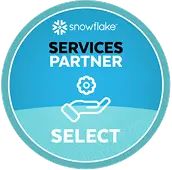Snowflake Data Ingestion
Ingestion Simplified. Insights Amplified.
Streamline your data workflows with efficient data ingestion to Snowflake. Automatically load, transform, and manage data from multiple sources to gain fast, reliable insights and make smarter decisions.

Home » Services » Snowflake Consulting » Data Ingestion





Snowflake Data Ingestion - Streamlining Your Data Pipelines
Businesses rely on efficient data ingestion processes to extract, load, and manage vast volumes of information across various systems. With the exponential growth of data, having a robust platform like Snowflake for data ingestion has become crucial for businesses aiming to stay competitive.
Snowflake's cloud-native architecture offers real-time data ingestion capabilities, scalable solutions, and structured and semi-structured data support. This makes it an optimal choice for modern enterprises looking to streamline their data pipelines and ensure data is readily available for analysis.
In this blog, we’ll explore Snowflake data ingestion, key practices to optimize the process, and how to use Snowflake’s built-in tools, like Snowpipe, for real-time ingestion.
What is Snowflake Data Ingestion?
Snowflake data ingestion refers to importing, transforming, and loading structured and semi-structured data into Snowflake’s cloud-based data platform. Snowflake offers multiple methods to facilitate this process, from batch loads to real-time streaming with Snowpipe.
These ingestion techniques enable businesses to process vast amounts of data efficiently, making it readily available for analysis and decision-making. Snowflake boasts the capacity to handle multiple petabytes of data daily. As of April 2024, the Snowflake marketplace has experienced more than 115,000 visitors monthly.
With features like Snowpipe and COPY INTO, businesses can optimize their data ingestion strategies, ensuring scalability, cost-effectiveness, and improved performance.

How Does Snowflake Data Ingestion Work?
Snowflake data ingestion imports transform and load data into the cloud data platform. This process involves extracting data from various sources, cleaning and preparing it, and then loading it into Snowflake tables.
Key Components of Snowflake Data Ingestion:
Data Sources
These can include databases, filesystems, cloud storage (like Amazon S3, Google Cloud Storage), or other applications.
Extraction
Data is extracted from these sources using various methods, such as database connectors, file readers, or APIs.
Transformation
The extracted data is often transformed to match Snowflake's data model or to prepare it for analysis. This might involve cleaning, filtering, or aggregating data.
Loading
The transformed data is then loaded into Snowflake tables using the COPY INTO command or the Snowpipe service.

What are the Different Snowflake Data Ingestion Methods?
Snowflake offers a variety of data ingestion methods to accommodate different data sources and processing requirements. These methods enable businesses to load data into Snowflake for analysis and efficient reporting. Working with a Snowflake consulting expert can help organizations streamline these processes and make the most of Snowflake's capabilities.
Batch Loading
This involves loading large amounts of data simultaneously, typically in a scheduled or manual process.
Real-Time Streaming
Using Snowpipe, data can be ingested continuously from sources like Kafka or Kinesis, allowing for near-real-time analytics.
API-Driven Ingestion
Snowflake provides APIs that can programmatically load data, giving you more control over the ingestion process.

Best Practices for Snowflake Data Ingestion
To maximize Snowflake data ingestion, businesses must follow best practices that enhance performance and ensure long-term scalability and efficiency
1. Snowpipe: Real-Time Data Ingestion
Snowpipe allows businesses to load data continuously into Snowflake with minimal delay. It automates the process of loading data from external sources like cloud storage or third-party applications into Snowflake tables in near real-time, without the need for manual intervention.
For businesses needing live data for analytics or operational purposes, Snowpipe’s capabilities provide a seamless solution to avoid bottlenecks. Key features include:
- Real-Time Ingestion: Snowpipe automatically loads new data files as they arrive in storage.
- Scalability: It dynamically scales based on the volume of incoming data.
- Simplicity: Users can set up ingestion pipelines without the need for complex ETL processes, saving time and resources.
2. Optimize Data File Size and Format
When ingesting data into Snowflake, the size and format of files can impact performance. To optimize the ingestion process:
- File Size: Snowflake recommends using files ranging from 100 MB to 1 GB for optimal loading performance. Larger files can slow down ingestion, while smaller files may increase overhead costs.
- File Format: Choosing efficient formats such as Parquet or Avro helps reduce load times and storage costs compared to traditional formats like CSV. These formats are optimized for analytical workloads and help reduce the overall size of the data, speeding up the ingestion process.
3. Compress Data for Faster Loading
Compressing data files before loading them into Snowflake significantly reduces ingestion times. Snowflake supports various compression algorithms, with GZIP being one of the most commonly used due to its effectiveness in reducing file sizes. Compressed data can be loaded faster, reducing costs and minimizing the time it takes to have data available for querying.
4. Monitor and Scale Ingestion Pipelines
Monitoring your data ingestion pipelines ensures you can adjust for volume spikes, downtime, or performance issues. Snowflake provides Query History and Resource Monitoring to give visibility into the performance of ingestion pipelines. Businesses can also set up alerts to notify administrators when issues arise, ensuring that any problems are addressed promptly.
5. Partition and Organize Data for Query Efficiency
Organizing ingested data into partitions ensures that queries can run more efficiently. Partitioning data based on attributes such as date, region, or product type allows for more focused queries, reducing the amount of data scanned during analysis. This practice also helps reduce costs and improve the performance of Snowflake queries.
6. Implement Security and Governance
Security is a critical aspect of data ingestion, particularly when dealing with sensitive or personally identifiable information (PII). Snowflake provides built-in security measures, such as encryption, role-based access controls, and compliance certifications to ensure that data is handled securely throughout the ingestion process. Businesses should also enforce data governance policies to track who has access to the ingested data and ensure compliance with regulations.
7. Snowpipe API vs. Auto-Ingest Snowpipe
Snowflake offers two methods for data ingestion using Snowpipe:
- Snowpipe API: This method gives you full control over when to load new data into Snowflake. It allows businesses to trigger data ingestion programmatically via API calls.
- Auto-Ingest Snowpipe: This method enables Snowflake real time data ingestion by automatically loading data as soon as it becomes available in your cloud storage. It’s best suited for businesses that require continuous and real-time data ingestion without manual intervention.
Each method has its use case. Auto-ingest Snowpipe is ideal for real-time data environments, while the API method gives more control for businesses that prefer a more hands-on approach.
8. COPY INTO vs. Snowpipe
While COPY INTO is useful for bulk data loads in batch mode, Snowpipe is better suited for real-time or continuous data ingestion. COPY INTO loads data manually or via scripts, which is less efficient for real-time operations. Snowpipe automates this process, allowing for seamless and scalable ingestion of data as it arrives in cloud storage.
Final Words
Snowflake data ingestion simplifies and optimizes the way businesses handle real-time and batch data pipelines. Using the best practices like optimizing file size, using Snowpipe for real-time ingestion, and implementing strong security measures, companies can ensure that their data is ingested efficiently and securely.
As organizations continue to scale, Snowflake's flexibility and real-time ingestion capabilities will remain critical in driving growth and operational efficiency. So, partner with Folio3 Cloud and Data services to maximize the Snowflake real-time data ingestion.
Real Results, Real Impact

We have been delighted by canibuild and we have very successfully incorporated the platform into our way of selling. Our New Homes Consultants have embraced the technology and love how it simplifies our sales process. The support from Tim, Jim and the canibuild office has been exceptional and their accessibility to all of our team has helped make the rollout of the platform so much easier.
Simon Curtis
G.J. Gardner Homes
Ready To Talk?
Let's explore your objectives and discover how our Snowflake Ingestion consultancy can drive your success.
Request A Call
Get in touch with our team to solve your queries.